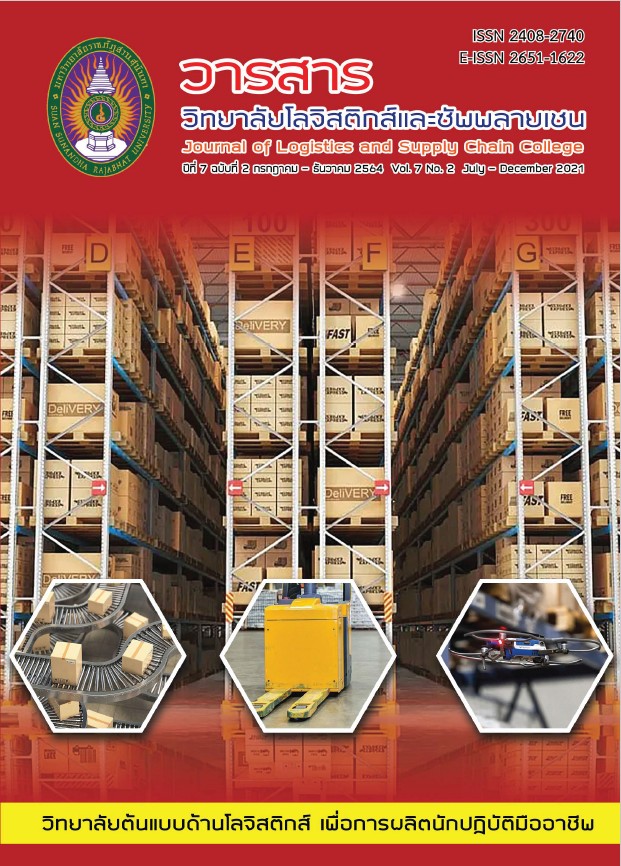Supply Chain Agility: An Adaptation Perspective on the Effect of the COVID-19 Pandemic on Tourism Entrepreneurs at Lad-Etan Island, Nakhon Pathom Province in Thailand
Keywords:
Supply Chain Agility, Adaptation, COVID-19, Tourism Entrepreneurs, Lad-Etan Island in ThailandAbstract
This research aims to find the proper means of establishing supply chain agility for adaptation stemming from the effects of COVID-19 pandemic on tourism entrepreneurs. We developed structural equation model represented supply chain agility by using mixed method based on collecting data obtained from nine groups of related Thai people with Lad-Etan Island tourism group namely; 1) hotels, homestays, 2) restaurants, 3) transportation, cross-river boats, sightseeing boats, 4) shops, gift shops, souvenir shops, 5) merchants of riverside market, 6) tourist attractions, fruit and agricultural gardens, 7) tourists and related people (such as temple), 8) tour companies, and 9) tourist information units around the area. The number of population for this research is large and unspecified where we collected questionnaire samples from 400 people and interviewed samples from 12 people. The descriptive statistics,path analysis, and structural equation modeling are selected data analysis techniques implemented in our study. The major findings are; (1) the supply chain agility consists of four major parts, which are logistics, organization, sensitivity, and information system, (2) model development (SCA-Lad-Etan Island Model). According to the result obtained from structural equation model analysis, supply chain agility gives positive impact to firms’ performance in term of time, flexibility or responsiveness, reliability, and costs or costs reduction. Furthermore, critical capabilities that requiring urgent management attention to survive this severe situations are such as managing tourism supply chain flow continuously, responsively, and seamlessly. As well as that the management of the costs in supply chain, targeting the lowest possible total costs for firms’ benefit.
References
Bangkokbiznews. (2020). Updated all day 'Corona Virus' situation. Bangkok Business Media Company Limited. Access from: https://www.bangkokbiznews.com/news/detail/864579, January 31, 2020.
Carvalho, H., Duarte, S. & Cruz Machado, V. (2011). Lean, agile, resilient and green: divergencies and synergies. International Journal of Lean Six Sigma, 2(2), 151-179.
Charles, A., Lauras, M. & Wassenhove, L.V. (2010). A model to define and assess the agility of supply chains: building on humanitarian experience. InternationalJournal of Physical Distribution & Logistics Management, 40(8/9), 722-741.
Fisher, M.L. (1997). What is the right supply chain for your product. Harvard Business Review, March/April, 105-116.
Gligor, D.M. & Holcomb, M.C. (2012). Understanding the role of logistics capabilities in achieving supply chain agility: a systematic literature review. Supply Chain Management: An International Journal, 17(4), 438–453.
Jitaphat Chaisit, Ladapa Pansuwan & Laphatsawat khaiseang. (2018). A Study of Factors Influencing the Travelling Decision and The Satisfaction of Tourists in Wat Pranonjaksre Community Market, Singburi Province. Journal of Logistics and Supply Chain College, 4(1), 76-90.
K-Research. (2020). The outbreak of the new strain of corona virus in just 1 month. It is expected to affect the Chinese economy by 2020 at least 300 billion yuan. Kasikorn Research Center, 26(3847), 1-4.
Khan K, A., Bakkappa, B., Metri, B.A. & Sahay, B.S. (2009). Impact of agile supply chains’ delivery practices on firms’ performance: Cluster analysis and validation. Supply Chain Management: An International Journal, 14(1), 41–48.
Li, X., Goldsby, T.J. & Holsapple, C.W. (2009). Supply chain agility: scale development. The International Journal of Logistics Management, 20(3), 408-424.
Martin, C. (2016). Logistics & Supply Chain Management (5th Edition). FT Publishing Financial Times, UK.
Martin, C. (2011). Logistics and Supply Chain Management: Creating Value-Adding Networks 4ED. FT Prentice Hall, UK.
Natpatsaya Setthachotsombut (2017). Using information Technology and innovation in Logistics Supply Chain and Value Chain. Journal of Logistics and Supply Chain College, 3(1), 4-15.
Natpatsaya Setthachotsombut & Gritsada Sua-iam. (2020). Tourism value chain management and tourism logistics in Ubon Ratchathani Province, northeast Thailand. African Journal of Hospitality, Tourism and Leisure, 9(1), 1-11.
Paixa˜o, A.C. & Marlow, P.B. (2003). Fourth generation ports – a question of agility. International Journal of Physical Distribution & Logistics Management, 33(4), 355-376.
Tieman,M., van der Vorst, J.G.A.J. & Che Ghazali, M. (2012). Principles in halal supply chain management. Journal of Islamic Marketing, 3(3), 217-243.
Vinodh, S. & Chintha, S.K. (2011). Application of fuzzy QFD for enabling agility in a manufacturing organization A case study. The TQM Journal, 23(3), 343-357.
Watchravesringkan, K., Karpova, E., Hodges, N.N. & Copeland, R. (2010). The competitive position of Thailand’s apparel industry Challenges and opportunities for globalization. Journal of Fashion Marketing and Management, 14(4), 576-597.
Wieland, A. (2013). Selecting the right supply chain based on risks. Journal of Manufacturing Technology Management, 24(5), 652-668.
Xia, Y. & Li-Ping Tang, T. (2011). Sustainability in supply chain management: suggestions for the auto industry. Management Decision, 49(4), 495-512.
Yamane, Taro. (1967). Statistics: An Introductory Analysis, 2nd Edition, New York: Harper and Row.



